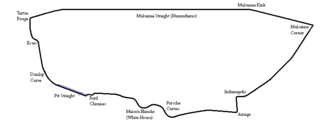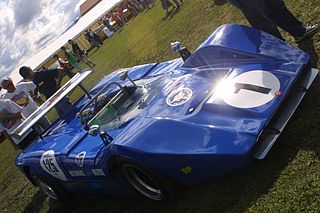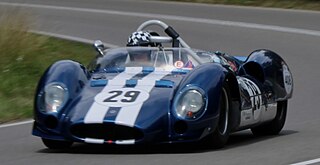Related Research Articles
Lola Cars International Ltd. was a British race car engineering company in operation from 1958 to 2012. The company was founded by Eric Broadley in Bromley, England, before moving to new premises in Slough, Buckinghamshire and finally Huntingdon, Cambridgeshire, and endured for more than fifty years to become one of the oldest and largest manufacturers of racing cars in the world. Lola Cars started by building small front-engined sports cars, and branched out into Formula Junior cars before diversifying into a wider range of sporting vehicles. Lola was acquired by Martin Birrane in 1998 after the unsuccessful MasterCard Lola attempt at Formula One.

The 1982 24 Hours of Le Mans was the 50th Grand Prix of Endurance, which took place on 19 and 20 June 1982. It was also the fourth round of the 1982 World Endurance Championship. As well as a significant anniversary, this was a watershed year for Le Mans, with the highly anticipated advent of the FIA's Group C regulations, the essence of which was to allow an open engine formula but a minimum weight for safety and a proscribed fuel allocation.

The 1972 24 Hours of Le Mans was the 40th Grand Prix of Endurance, and took place on 10 and 11 June 1972. It was the ninth round of the 1972 World Championship for Makes.
The 1982 World Sportscar Championship was the 30th season of FIA World Sportscar Championship racing. It featured the 1982 World Endurance Championship for Drivers, which was contested over an eight-round series, and the 1982 World Endurance Championship for Manufacturers, which was contested over five rounds held concurrently with the first five rounds of the Drivers Championship. The Drivers’ title was open to Group C Sports Cars, Group B GT Cars, Group 6 Two-Seater Racing Cars, Group 5 Special Production Cars, Group 4 GT Cars, Group 3 GT Cars, Group 2 Touring Cars and IMSA GTX, GTO and GTU cars. The Manufacturers title was limited to Group C Sports Cars and Group B GT Cars only. The series ran from 18 April 1982 to 17 October 1982.
Group 5 was an FIA motor racing classification which was applied to four distinct categories during the years 1966 to 1982. Initially Group 5 regulations defined a Special Touring Car category and from 1970 to 1971 the classification was applied to limited production Sports Cars restricted to 5 litre engine capacity. The Group 5 Sports Car category was redefined in 1972 to exclude the minimum production requirement and limit engine capacity to 3 litres. From 1976 to 1982 Group 5 was for Special Production Cars, a liberal silhouette formula based on homologated production vehicles.

Ray Mallock Ltd., also known as RML Group, is a motorsports and high performance engineering company, based in Wellingborough, Northamptonshire, United Kingdom.

The Lola T92/10 was a Group C sports car developed by Lola Cars as a customer chassis for the 1992 World Sportscar Championship season. It would be the final sports car built by Lola until their return in 1998.
The 1984 Australian Sports Car Championship was an Australian motor racing title open to Sports Cars complying with CAMS Group A regulations. It was the 16th Australian Sports Car Championship.

The Lola T600 was a racing car introduced in 1981 by Lola Cars as a customer chassis. It was the first GT prototype race car to incorporate ground-effect tunnels for downforce. The revolutionary aerodynamic design of the T600 was widely imitated throughout the 1980s by International Motor Sports Association (IMSA) and Group C prototype cars. The Lola T600 ran initially in the U.S.-based IMSA GT series and later in European Group C races.

Group A Sports Cars is an Australian motor racing category that CAMS formulated for sports car racing in Australia. Introduced in 1964, it continues today under the name Group 2A Sports Cars.
The 1985 Australian Sports Car Championship was a CAMS sanctioned motor racing title for drivers of Group A Sports Cars. It was the 17th Australian Sports Car Championship and the first to be run concurrently with the Australian GT Championship.
The Lola T610 was a ground effect Group C2/IMSA GTP Lights sports prototype race car, designed, developed and built by British manufacturer Lola, for sports car racing, specifically the World Sportscar Championship and 24 Hours of Le Mans, in 1984.

The Buick Indy V6 engine is a powerful turbocharged, 3.0–3.4 L (180–210 cu in), V-6, Indy car racing internal combustion engine, designed and produced by Buick for use in the C.A.R.T. PPG Indy Car World Series, and later the IRL IndyCar Series; between 1982 and 1997. It shares the same architecture, and mechanical design, and is based on the Buick V6 road car engine. A slightly destroked 3.0-liter V6 engine was also used in the March 85G and March 86G IMSA GTP sports prototypes.
The Cougar C02 was a Group C sports car prototype race car, designed, developed, and built by French constructor Cougar in 1983, and used in sports car racing from 1983 to 1984. It was the successor the C01. Its best result was at the 1984 500 km of Watkins Glen, where drivers Yves Courage and John Jellinek, and Alain de Cadenet finished in 9th-place, respectively.
The Sauber C3 was the third sports prototype racing car that Swiss Peter Sauber designed and developed. It was built in 1973. It scored one race win, seven podium finishes, clinched one pole position, and achieved three additional wins in its class. It was powered by a naturally aspirated 2.0 L (120 cu in) Ford-Cosworth BDG four-cylinder engine, developing 280 hp (210 kW).

The Cooper T61 , also known as the Cooper T61 Monaco, or the Cooper Monaco T61, is a sports racing car, designed, developed and built by British manufacturer Cooper, in 1961. It is the successor and evolution of the T57. Its motor racing career spanned 6 years ; where it won a total of 16 races, achieved 23 podium finishes, and clinched 3 pole positions. It was powered by a number of different engines, including a Coventry Climax four-cylinder engine, a Maserati V8 engine, a Ford FE engine, and a Chevrolet small-block engine.
The Zytek ZA1348, also known as the Zytek ZA348, is a 3.4-liter, naturally-aspirated, V8 racing engine, designed, developed and produced by British manufacturer Zytek, between 2003 and 2004. It was specifically constructed and built as the spec-engine for the new A1GP open-wheel formula racing series, and debuted in 2005. It powered the Lola B05/52 A1 Grand Prix car. It produced between 520–550 hp (390–410 kW), and around 330 lb⋅ft (450 N⋅m) of torque. A slightly detuned version of the engine, producing around 400 hp (300 kW), but a similar torque figure of 326 lb⋅ft (442 N⋅m), was used in the Ginetta G50Z sports racing car. The engine itself is very light, weighing only 120 kg (260 lb), constructed out of cast aluminum alloy.

The Lola T280, and its evolutions, the Lola T282, Lola T284, and Lola T286, are a series of 3-liter Group 5 sports prototype race cars, designed by Eric Broadley, John Barnard, and Patrick Head, and developed and built by British manufacturer and constructor Lola, for World Sportscar Championship sports car racing, between 1972 and 1976.

The Lola T380 is a 3-litre Group 5 sports prototype, designed, developed and built by British manufacturer and constructor Lola, for sports car racing, in 1975.
The Lola T490 is a 2-litre Group 5 Sports 2000 prototype race car, designed, developed and built by British manufacturer Lola, for 2-litre sports car racing, in 1977.
References
- ↑ "Lola T610, 1982 [Auta5P ID:8564 EN]". auta5p.eu.
- ↑ "Lola T610 Specifications". www.geocities.ws.
- ↑ "Lola T610" . Retrieved 6 November 2022.
- ↑ "Lola T610 group C (1982) - Racing Cars". tech-racingcars.wikidot.com.
- ↑ "Lola Heritage". www.lolaheritage.co.uk.